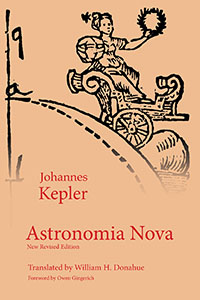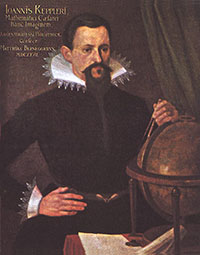Astronomia Nova
by Johannes Kepler, translated by William H. Donahue, Foreword by Owen Gingerich
8" x 12", 574 pages, Glossary, Bibliography, Index.
New Revised Edition, 2015.
For pricing and ordering information, see the ordering section below.
 Second edition, completely revised, of the only English translation of Kepler's 1609 masterpiece. A work of astonishing originality, Astronomia Nova stands, with Copernicus's De Revolutionibus and Newton's Principia, as one of the founding texts of the scientific revolution. Kepler revolutionized astronomy by insisting that it be based upon physics rather than ideal geometrical models. Includes many new features, including a comprehensive index.
Second edition, completely revised, of the only English translation of Kepler's 1609 masterpiece. A work of astonishing originality, Astronomia Nova stands, with Copernicus's De Revolutionibus and Newton's Principia, as one of the founding texts of the scientific revolution. Kepler revolutionized astronomy by insisting that it be based upon physics rather than ideal geometrical models. Includes many new features, including a comprehensive index.
Features
- First formulation of Kepler's first two laws of planetary motion
- Introduces physical forces and noncircular orbits into astronomy
- Lays the foundation for Newton's universal gravitation
About the Translation
The first edition of this translation was published by Cambridge University Press in 1992, but has long been out of print. After Green Lion Press acquired the rights, Donahue completely revised the translation with the assistance of classicist Bruce M. Perry, and added much material, including a listing of Tycho Brahe's Mars observations and accounts of Kepler's use of them, as well as a comprehensive index, which was lacking in the Cambridge edition. The book is newly laid out in a handsome 8 inch by 12 inch format, with Green Lion Press's acclaimed layout and production standards.
Reviews
"Donahue prudently allows Kepler 'the courtesy of supposing that what he writes can be understood,' and has managed a translation that preserves a good bit of the style of the Latin: sometime elevated, frequently jocular, on occasion impassioned. The English almost always seems faithful in tone to the original. … a reliable and readable rendering of a difficult text that makes a great deal of fascinating material accessible to those unwilling to face Kepler's Latin."
—Bruce Stephenson
Adler Planetarium
Author of Kepler's Physical Astronomy
"Donahue's translation is readable and technically secure, and his footnotes explain obscure points in the text. His introduction and glossary give sufficient information concerning Kepler's methods and notation to assist a reader who has not previously dealt with Renaissance astronomy."
—Leroy Doggett
U. S. Naval Observatory
"One immediately notices that this second English edition has a substantially enlarged page size. Kepler's original volume was more than 35 cm tall, thereby leaving enough room for fully displayed computations and tables. The choice of displaying the synopsis of the entire work in one larger page is very fortunate (pp. 38-39). Furthermore, the high quality of the diagrams should be noted.
... The book is a powerful tool for teaching purposes, highly recommended to undergraduate students in the history of science and to the non-specialist audience. "
—Silvia De Bianchi
Mathematical Reviews
Sample pages
Below are links to PDF versions of Donahue's short essay on Astronomia Nova and the Table of Contents.
You may need to open these PDF documents in Adobe Reader or an equivalent program.
- About Astronomia Nova
- Table of Contents
- Mars Orbit to Scale
Other links:
About the Author
 Johannes Kepler was born in 1571 in Weil-der-Stadt, a small town in southern Germany. He was educated in the duchy of Württemberg, first in the Latin school and then in the seminaries at Adelberg and Maulbronn. At the age of sixteen, he won a scholarship to the University of Tübingen, where, while preparing to become a Lutheran minister, he studied astronomy under Michael Maestlin, who introduced Kepler to the heliocentric system of Copernicus. Kepler became an ardent Copernican, although he had no intention of
becoming an astronomer.
Johannes Kepler was born in 1571 in Weil-der-Stadt, a small town in southern Germany. He was educated in the duchy of Württemberg, first in the Latin school and then in the seminaries at Adelberg and Maulbronn. At the age of sixteen, he won a scholarship to the University of Tübingen, where, while preparing to become a Lutheran minister, he studied astronomy under Michael Maestlin, who introduced Kepler to the heliocentric system of Copernicus. Kepler became an ardent Copernican, although he had no intention of
becoming an astronomer.
Upon graduation, he was asked by his patron, the Duke of Württemberg, to teach mathematics at a provincial school in Graz, Austria. Here he developed his unique cosmology involving nested Platonic solids that determined the planetary orbits. This system was published in 1596 as Mysterium Cosmographicum, a book which brought Kepler to the notice of the brilliant observational astronomer Tycho Brahe. Brahe invited Kepler to join his research team, which Kepler was eventually driven to do owing to Brahe's removal to Prague and anti-Lutheran purges in Graz.
In Prague, Kepler was assigned to work on Mars, an event in which Kepler saw the hand of Providence (see Chapter 7 of Astronomia Nova). Although relations with Brahe, and later, with Brahe's heirs, were difficult, Kepler was appointed Brahe's successor as Imperial Mathematician, a position he held for the rest of his life. While in Prague, he did much of his finest work, reforming the science of optics with his Astronomiae Pars Optica of 1604, and starting a revolution in astronomy with Astronomia Nova in 1609.
Over the subsequent decades, despite extremely difficult circumstances (for example, the events of the Thirty Years' War of 1618–1648), Kepler made numerous contributions to both astronomy and mathematics. His life's work culminated in the publication of the massive Tabulae Rudolphinae of 1627, the accuracy of which established his difficult theories as the standard of excellence. He died in Regensburg in 1630, while on a journey attempting to collect his salary from the imperial treasury.
About the Translator
 William H. Donahue has been studying Kepler's works, especially Astronomia Nova, for fifty years. His interest in Kepler was first sparked as a student at St. John's College in Annapolis, where selections from Kepler's Epitome of Copernican Astronomy were part of the college's celebrated great books program. Hearing the claim that Kepler's greatest work was the hitherto untranslated Astronomia Nova, he wrote his senior essay on it, reading it in Latin. Later, while on the faculty of the Santa Fe campus of St. John's, he translated selections for an Astronomia Nova preceptorial which he led.
William H. Donahue has been studying Kepler's works, especially Astronomia Nova, for fifty years. His interest in Kepler was first sparked as a student at St. John's College in Annapolis, where selections from Kepler's Epitome of Copernican Astronomy were part of the college's celebrated great books program. Hearing the claim that Kepler's greatest work was the hitherto untranslated Astronomia Nova, he wrote his senior essay on it, reading it in Latin. Later, while on the faculty of the Santa Fe campus of St. John's, he translated selections for an Astronomia Nova preceptorial which he led.
Leaving St. John's to help found a small innovative school, Donahue continued to work on the translation while teaching mathematics and science and developing the school's extensive outdoor program. In 1981, a grant from the National Science Foundation allowed him to take time off to complete the translation, which was eventually published by Cambridge University Press in 1992. That edition has long been out of print, and demand has been strong for a new edition, which is met at last by the present book.
Donahue received further support from the National Endowment for the Humanities for a guided study of Astronomia Nova and for the first English translation of Kepler's Optics. These books were later published by Green Lion Press, which Donahue and his wife Dana Densmore founded in 1995.
In 2005, Donahue returned to the faculty of St. John's College, Santa Fe, where he has served as Director of Laboratories, supervising the college's unique science curriculum based on study of original sources in science, from the ancient Greeks to modern quantum physics and ecology.
